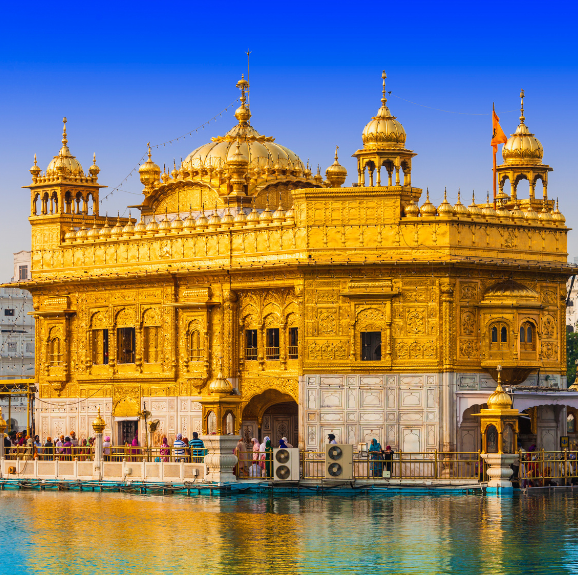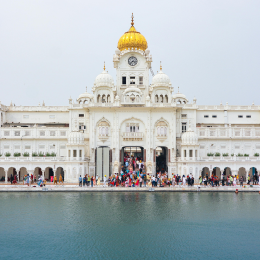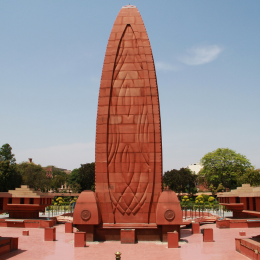Amritsar, situated in the northern state of Punjab, is one of India’s most iconic and culturally significant cities. Known as the spiritual heart of Sikhism, Amritsar is home to the Golden Temple (Harmandir Sahib), a revered site for Sikhs around the
world. Beyond its religious significance, Amritsar is a city that embodies deep-rooted history, vibrant culture, and resilience, making it an unforgettable destination for anyone seeking to understand the
spiritual and cultural essence of India.
Amritsar: The Spiritual Heart of Sikhism
Punjab, India



Overview
Historical and Spiritual Significance
Amritsar was founded in 1577 by Guru Ram Das, the fourth Sikh Guru, who established the city around the Amrit Sarovar (the Holy Pool of Nectar), which is believed to have healing properties. Guru Ram Das’s vision was to create a place where people from
all faiths could come together in harmony, and this spirit of inclusivity continues to resonate in the city today.
The Golden Temple, also known as Harmandir Sahib, is the most important landmark in Amritsar. It was built by Guru Arjan Dev in the late 16th century, with its construction symbolizing the values of equality, service, and community. Over the centuries,
Amritsar has been a center of both religious and political history. The city was a focal point during the Indian independence movement, particularly during the tragic Jallianwala Bagh massacre of 1919. The
massacre, where British troops killed hundreds of unarmed civilians, remains a key event in the history of India’s struggle for freedom. Today, the site serves as a memorial to those who lost their lives,
serving as a somber reminder of the sacrifices made in the fight for independence.
Key Attractions
Golden Temple (Harmandir Sahib)
Jallianwala Bagh Memorial
Wagah Border
Durgiana Temple
Maharaja Ranjit Singh Panorama
Amritsar is also famous for its mouthwatering Punjabi cuisine, which reflects the city’s rich agricultural heritage and vibrant culture. One of the most popular dishes is Amritsari Kulcha, a type of stuffed flatbread, which is often paired with Chole,
spicy chickpeas. Lassi, a refreshing yogurt-based drink, is another staple, especially when enjoyed in one of the many local dhabas (eateries). Kesar Peda, a sweet dessert made from condensed
milk, is famous in Amritsar and is often enjoyed during festivals and special occasions.
The city is renowned for its hospitality, and this cultural trait is most evident in the Langar tradition at the Golden Temple, where tens of thousands of people are served free meals daily. The concept of Langar is central to Sikh teachings of selfless
service (Seva) and equality, and visitors from all around the world can partake in this meal, irrespective of their background.
Amritsar is a city that celebrates a number of religious and cultural festivals with great fervor. One of the most significant festivals is Baisakhi, celebrated in April to mark the harvest season and the formation of the Khalsa in 1699. During Baisakhi, the Golden Temple is beautifully illuminated, and the city sees grand processions and religious celebrations.
The Gurpurabs —celebrations of the birthdays of the Sikh Gurus—are also key events in Amritsar. These include special prayers at the Golden Temple, processions, and community events
that bring together Sikhs and visitors from all over the world to celebrate their faith.
Conclusion
Amritsar is a city where the past and present coexist harmoniously, offering visitors a deep connection to Sikhism, Indian history, and cultural heritage. From the serene beauty of the Golden Temple to the poignant memories of the Jallianwala Bagh massacre,
Amritsar’s significance extends beyond religion and history. It is a city that welcomes people from all walks of life with open arms, offering peace, unity, and service to all who visit.
With its rich culture, historic significance, and deep spiritual roots, Amritsar stands as a beacon of peace, resilience, and selfless service, making it one of India’s most remarkable cities to explore.

